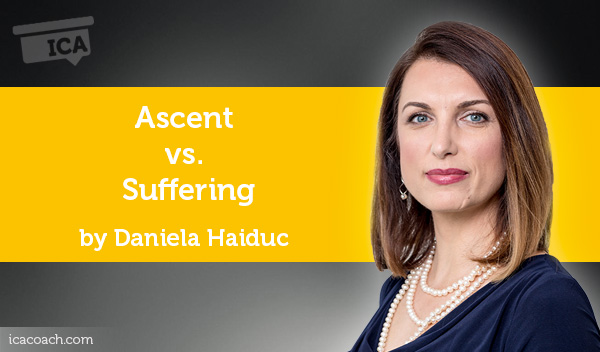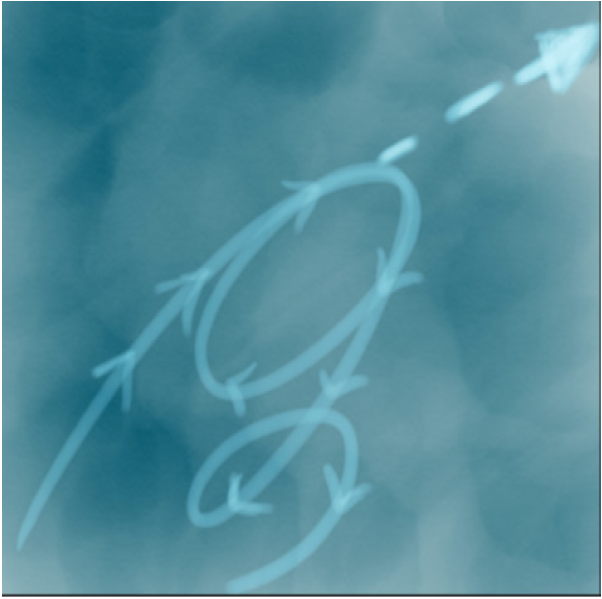
A Coaching Power Tool Created by Daniela Haiduc
(Transformational/Life/Business Coach, UNITED STATES)
It is not the strongest species that survive, nor the most intelligent, but the most responsive to change. – Charles Darwin
The human race has survived for hundreds of thousands of years mainly due to its ability not only to adapt to ever changing circumstances but thrive in newly developed environments, at times even creating them. The evolution was possible, in many cases, due to a capability and a desire for progress, leading me to believe that growing and changing ahead of, with, or because of our environments is in our genes and, when we oppose these forces towards evolution, we can become trapped in suffering.
Ascent = (1) a: the act of rising or mounting upward; b: an upward slope or rising grade; c: the degree of elevation. (2) an advance in social status or reputation
Suffering = (1) the state or experience of one that suffers. (2) pain
In considering changes, there are some that occur in connection with the exterior world, and some that are internal to each individual.
Fluctuations in our geographic and socio-economic environments, especially in a rapidly paced, technology-driven society, are inevitable. The environment can also take the meaning of social environment for instance, in the form of family, friends, neighbors, co-workers, etc. Whether the shifts in the environment are in one’s circle of control, circle of influence or neither, can make a difference in the way one responds to these changes and the reaction they generate. In general, changes can be interpreted as a threat – and thus creating feelings of fear, uncertainty, lack of clarity, a freeze/flight/fight reaction – or as an opportunity, resulting in feelings of excitement, renewed energy and passion, and a desire for action. If the change is significant enough, the emotional state of an individual, his/her attitude towards it, can fluctuate, impacting consequent actions or lack thereof. As an example, receiving a promotion may, at first, be seen as an extremely gratifying experience, one that solicits positive energy and thoughts, and plans being put into place; this event can also cause fears around the ability to perform well in the new role, to adapt to the new environment, etc.
Individuals could also experience internal changes, which are not caused by evident outer factors, tend to be subtler and gradual, can be extremely powerful, and can result from ageing, reading, revelations, etc. These changes can lead to similar feelings as the external-led shifts, depending on each individual, his/her beliefs, values and perspectives on and expectations from life. They can be met with resistance and cause suffering, or they can be embraced and even celebrated as transformational opportunities.
As discussed so far, change was a result of an internal or external shift, experienced by people as subjects of change. Moreover, change can be intentional, driven by a desire for progress, for new challenges, experiences and discovery. Individuals with a high degree of comfort around change may seek it purposefully, having understood the value of undergoing transformation as a catalyst for growth.
The response and management of change can make the difference between experiencing an ascent or suffering. While some naturally embrace change, and embark in an upward spiral of progress, many other individuals can find themselves struggling to accept it. The toil to face a new reality, a different set of circumstances, or to understand the emotions around change or even changing emotions, can lead to suffering. For many, when reality doesn’t align with expectations, there is a deep sense of loss of the outcome they desired and a struggle to let go of that end-result and to learn how to adapt to the present circumstances. Similar suffering can be caused internally by an anticipation of negative things to come surrounding a recent or an upcoming change; for example, moving to another state could bring about questions around the ability to fit in, to adapt to a new environment, or fears of letting go of the current state-of being or fears of the unknown that can become greater with increased focus on them. Suffering is a choice that the individual makes unconsciously by putting energy into building negative thoughts. These feelings and perception of reality can have numerous negative impact on the life of the person in the downward spiral, as well as on the lives of those around that individual. Anxiety, depression, low energy and lack of motivation often present themselves as results of an unexpected, undesirable change. This self imposed suffering can also lead to a desire for isolation, lack of sleep or appetite, as well as more extreme behaviour such as substance abuse. The individual experiencing such a transformation may feel disempowered and he/she will require time and energy spent to understand the origins of the struggle and what can be done to shift from that state to one of growth and positivity; from a downward spiral focused on the negative, on thoughts and feelings of loss or lack, to an ascendant spiral of evolution.
 As humans, we are on a spiral of progression. We could find ourselves energized by a new perspective, an event, a revelation or new feelings arising within ourselves. Or we could be faced with an unpredicted event or change of circumstances, that throws us “off course”, meaning off the path we saw ourselves moving towards. In this case, a bend in the spiral occurs. If the focus remains on the loss of the path we were on, what we have done “wrong” or what could have been different, the experience can lead to feelings of frustration, unhappiness or depression even. It takes effort to shift from that downward trajectory – an effort to change perspectives, to reconsider our role in the past and how we affect the future path, to regain a sense of confidence in ourselves and our ability to construct a different path from where we are. The more energy or resources in general that are put into this phase of the spiral, the greater the momentum for ascension. The spiral then takes a rising form again, although different from the one we were experiencing before change intervened.
As humans, we are on a spiral of progression. We could find ourselves energized by a new perspective, an event, a revelation or new feelings arising within ourselves. Or we could be faced with an unpredicted event or change of circumstances, that throws us “off course”, meaning off the path we saw ourselves moving towards. In this case, a bend in the spiral occurs. If the focus remains on the loss of the path we were on, what we have done “wrong” or what could have been different, the experience can lead to feelings of frustration, unhappiness or depression even. It takes effort to shift from that downward trajectory – an effort to change perspectives, to reconsider our role in the past and how we affect the future path, to regain a sense of confidence in ourselves and our ability to construct a different path from where we are. The more energy or resources in general that are put into this phase of the spiral, the greater the momentum for ascension. The spiral then takes a rising form again, although different from the one we were experiencing before change intervened.
Coaching application
Most if not all coaching clients start seeking the assistance of a professional coach in a quest for a more positive experience and/or set of feelings or attitude, or to move away from a negative situation they have been experiencing. Processing change falls perfectly under this umbrella of topics to explore during coaching.
As change is all around and within us, there are numerous examples of what could cause the shift in the direction of one’s spiral. By providing a trusting space for exploration of the suffering in the downward spiral, a coach can facilitate the understanding of the current status of the client. In acting with care and compassion for the client, listening intently, and asking powerful questions, the coach can assist the client in learning about underlying beliefs, reflecting on his/her feelings towards change, and the current state he/she finds himself/herself in. With the help of shifts in perspective, or visualisation exercises, the coach can then see the client move towards a state of acceptance, feeling more empowered and even become enthusiastic about taking action that would propel him/her upwards once more. From this perspective, the coach would be in fact a resource that the client can use in building a powerful momentum as he/she creates an upward bend in their spiral.
The only thing that is constant is change. – Heraclitus, 535-475 BC
Works Cited
1. Merriam Webster Dictionary: merriam-webster.com; accessed 10 June 2018.